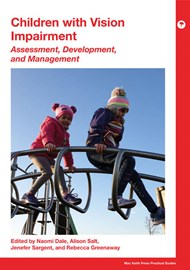Childhood blindness is a major public health concern worldwide with several implications ranging from a child’s development, education, and employment opportunities to social and functional challenges. This book offers a succinct, sequential approach to understanding conditions which lead to visual impairment right from the fundamentals, and defines current approaches to support and empower young people living with these conditions.
This book consists of 21 chapters further divided into four sections with every chapter building on information using a clear and structured format. Part One uses a ‘back to basics’ approach to describe the neuro-ocular pathways involved in visual processing followed by an introduction into disorders causing vision impairment.
Part Two assesses how vision impairment affects areas of development and cognition, especially in the early years. From infants to school-aged children, this section explicitly describes the impact of visual impairment on motor, language, and social development as well as how to identify and manage it. This provides clinical value to professionals working with children on a regular basis.
In the third section, habilitation approaches and their role in creating independence are further described. The authors focus on strategies to empower young adults in mobility, orientation, and autonomy with everyday tasks. It highlights the positive impact of multidisciplinary teams in enabling people to live fully functioning lives.
Part Four incorporates the experiences of a young adult with vision impairment which brings this book to life, allowing the reader to get a real in-depth understanding of challenges faced by children with visual impairment. This chapter also describes approaches to support young adults as they live with conditions causing visual impairment.
To conclude, this book provides clinicians with knowledge, skills, and practical guidance to assist children with vision impairment using a holistic approach. It also describes reliable assessment methods and rehabilitation practices that clinicians can integrate in their day-to-day practice, not to mention the valuable section on summaries and key points at the end of every chapter. This key guide also amalgamates research and evidence-based medicine in every chapter, offering the most up-to-date information. Considering the authors’ and editors’ extensive experiences working with children and families, this book is a must have for anyone working with paediatric vision impairment.





